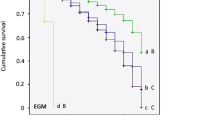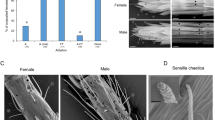Abstract
The host selection process ofBlepharipa pratensis (Meigen), a tachinid parasite of the gypsy moth,Lymantria dispar L., was investigated. Once in the host's habitat, and following contact with a recently damaged leaf edge (cut, torn, eaten), the fly orients perpendicular to the edge and moves back and forth with the front tarsi grasping the damaged edge. Oviposturing (oviposition intention) may occur. Leaf exudates appear to arrest the fly on the leaf and increase tarsal examination (searching). If an edge of a gypsy moth-eaten leaf is contacted, oviposition usually occurs. Significantly more eggs are laid when host-browsed foliage is encountered, compared to mechanically cut or damaged foliage, indicating response to a cue left by the host during feeding. The number of host-damaged leaf clusters in an area significantly enhances oviposition there; in field-cage tests, significantly more eggs (7911) were laid in simulated-crown areas with all clusters browsed, compared to the adjacent areas containing 1/2 browsed (4200 eggs) and undamaged clusters (2209 eggs). A host selection sequence is suggested and discussed.
Similar content being viewed by others
References
Bess, H.A. 1936. The biology ofLeschenaulta exul Townsend, a tachinid parasite ofMalacosoma americana Fabr. andMalacosoma disstria Hbn.Ann. Entomol. Soc. Am. 29:593–613.
Dethier, V.G., Browne, L.B., andSmith, C.N. 1960. The designation of chemicals in terms of the responses they elicit from insects.J. Econ. Entomol. 53:134–136.
Dowden, P.B. 1934.Zenillia libatrix Panzer, a tachinid parasite of the gypsy moth and brown-tail moth.J. Agric. Res. 48:97–114.
Embree, D.G., andSisojevic, P. 1965. The bionomics and population density ofCyzenis albicans (Fall.) (Tachinidae: Diptera) in Nova Scotia.Can. Entomol. 97:631–639.
Flanders, S.E. 1942. Oosorption and ovulation in relation to oviposition in the parasitic Hymenoptera.Ann. Entomol. Soc. Am. 35:251–266.
Godwin, P.A., andOdell, T.M. 1981.Blepharipa pratensis (Meigen) (Diptera: Tachinidae), pp. 375–394,in C.C. Doane and M.L. McManus (eds.). The Gypsy Moth: Research Toward integrated Pest Management. U.S. Dep. Agric. Tech. Bull. 1584.
Gross, H.R., Jr. 1981. Employment of kairomones in the management of parasitoids, pp. 137–150,in D.A. Nordlund, R.L., Jones, and W.J. Lewis (eds.). Semiochemicals: Their Role in Pest Control. John Wiley & Sons, New York.
Hassel, M.P. 1968. The behavior response of a tachinid fly,Cyzenis albicans (Fall.) to its host, the winter moth (Operophterabrumata (L.)).J. Anim. Ecol. 37:627–639.
Herting, B. 1960. Biologie der westpalaarktischen Raupenfliegen, Dipt. Tachinidae.Monogr. Angew. Entomol. 16. Verlag Paul Parey, Hamburg. 188 pp.
Howard, L.O., andFiske, W.F. 1912. The Importation into the United States of the Parasites of the Gypsy Moth and Brown-Tail Moth. U.S. Dep. Agric. Bur. Entomol. Bull. 91.
Hoy, M.A. 1976. Establishment of gypsy moth parasitoids in North America: An evaluation of possible reasons for establishment or non-establishment, pp. 215–232,in J.F. Anderson and H.K. Kaya (eds.). Perspectives in Forest Entomology. Academic Press, New York.
Lewis, W.J.,Jones, R.L.,Nordlund, D.A., andGross, H.R., Jr. 1975. Kairomones and their role in pest management. Proc. 8th Annual Northeastern Forest Insect Work Conference. New Haven, Connecticut.
Monteith, L.G. 1964. Influence of the health of the food plant on the host and host-finding by tachinid parasites.Can. Entomol. 96:1477–1482.
Nettles, W.C., Jr. 1982. Contact stimulants fromHeliothis virescens that influence the behavior of females of the tachinid,Eucelatoria bryani.J. Chem. Ecol. 8:1183–1191.
Odell, T.M., andGodwin, P.A. 1979a. Laboratory techniques for rearingBlepharipa pratensis, a tachinid parasite of gypsy moth.Ann. Entomol. Soc. Am. 72:632–635.
Odell, T. M., andGodwin, P.A. 1979b. Attack behavior ofParasetigena silvestris in relation to host density and behavior.Ann. Entomol. Soc. Am. 72:281–286.
Odell, T.M., andMastro, V.C. 1980. Crepuscular activity of gypsy moth adults.Environ. Entomol. 9:615–617.
Pschorn-Walcher, H. 1974. Gypsy moth (Porthetria dispar): Work in Europe, 1974.Annual Project Statement, Commonwealth Institute of Biological Control. 17 pp.
Roth, J.P., King, E.G., andThompson, A.C. 1978. Host location behavior by the tachinid,Lixophaga diatraeae.Environ. Entomol. 7:794–798.
Sato, Y. 1979. Experimental studies on parasitization byApanteles glomeratus. IV. Factors leading a female to the host.Physiol. Entomol. 4:63–70.
Sisojevic, P. 1975. Population dynamics of tachinid parasites of the gypsy moth during a gradation period.Zast. Bilja. 132:97–170. (in Serbo-Croatian).
Vinson, S.B. 1976. Host selection by insect parasitoids.Annu. Rev. Entomol. 21:109–133.
Weseloh, R. M. 1977. Effect of behavior ofApanleles melanoscelus females caused by modifications in extraction, storage, and presentation of gypsy moth silk kairomone.J. Chem. Ecol. 3:723–735.
Author information
Authors and Affiliations
Rights and permissions
About this article
Cite this article
Odell, T.M., Godwin, P.A. Host selection byBlepharipa pratensis (Meigen), a tachinid parasite of the gypsy moth,Lymantria dispar L.. J Chem Ecol 10, 311–320 (1984). https://doi.org/10.1007/BF00987859
Received:
Revised:
Issue Date:
DOI: https://doi.org/10.1007/BF00987859




